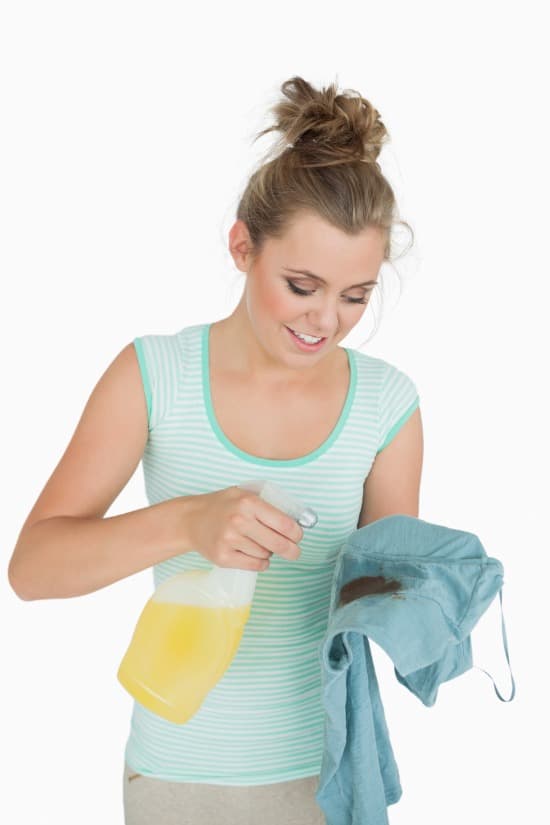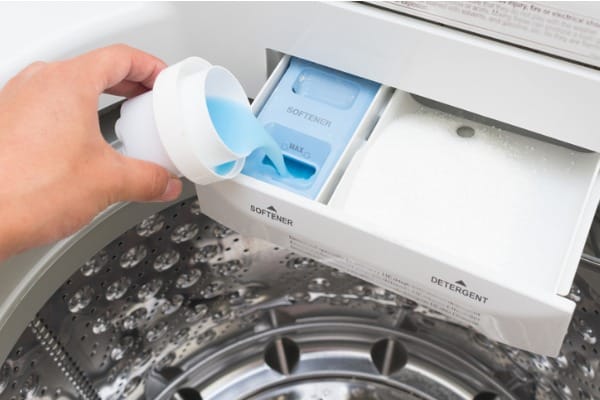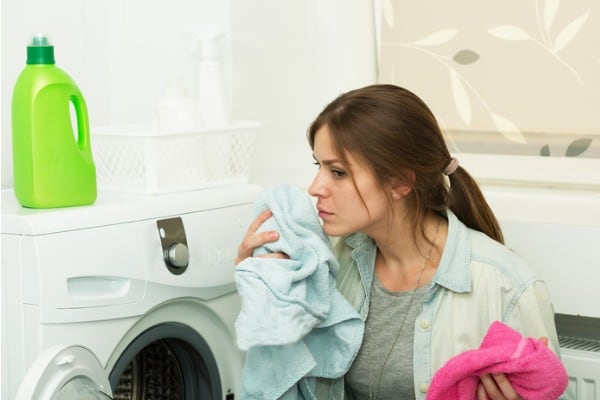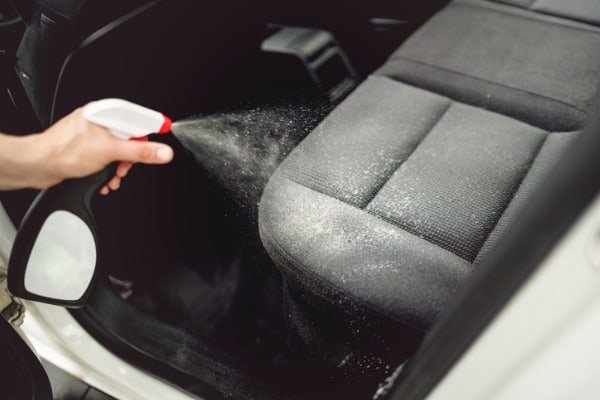A dog urine accident on clothing isn’t as big of a challenge as getting pee out of carpets or even an accident on your couch. Of course, each scenario warrants a good cleaning.

The nature of our clothing and the modern convenience of a washing machine makes the job easier than a carpet accident.
Can you really toss a urine-stained shirt into the wash and hope for the best?
Not quite.
Urine stains and smells are formidable adversaries when it comes to fabrics, and a simple wash or even a spin through the heavy-duty cycle won’t do the trick.
In fact, not treating stains on clothes in a specific way could make things worse.
Washing dog urine out of fabric requires a few extra steps, which will save your garments.
The good news?
Nothing in the method I’m recommending involves harsh chemicals which can cause damage to your clothes.
What You Should Know about Urine and Clothes
There could be a number of reasons dog urine found its way onto your clothing.
Cuddling a squirming, excited puppy, caring for an incontinent dog who leaks urine, or cleaning up a urine puddle can all result in a mess on your clothes.
Perhaps you have a dog who decided to mark or otherwise relieve itself on a laundry basket, and now you have multiple items of clothing to clean.
Are washing machines good enough?
It’s understandable to think washing machines – especially the high-tech ones we see today – are enough to combat the problem.
However, even adding extra detergent to your load of urine-stained laundry might not eliminate the odors.
You’re potentially facing multiple washes, which won’t even be as effective as the method I’m about to introduce.
3 Steps to Cleaning Dog Urine from Clothing
How to remove dog urine from clothes?
As I promised, no harsh or toxic chemicals are necessary.
I’m recommending an effective treatment method that combines enzyme cleaner and vinegar.
Let’s Get Prepared
It’s best to take care of urine stains on clothing while they’re still fresh.
So unless it’s simply impossible, I recommend dropping everything else and treating a urine accident as soon as it happens.
Here’s the yucky part – it’s good to wring out or otherwise blot out excess urine before tackling any additional treatment.
You’d do the same if your dog had an accident and you saw urine soaking into your hardwood floor, right?
If you’re uncomfortable with coming into further contact with the urine (See: Is Dog Urine Harmful to Humans?) or don’t have protective gloves, you can try the “jelly roll” method.
Take the wet article of clothing – a shirt, for example – and lay it out on top of an old towel – preferably one you don’t mind using to clean up organic stains.
Roll everything up like you would a burrito.
You should have a roll with the shirt inside and the towel on the outside.
Apply pressure to the roll, which will help wick urine out of the shirt and into the towel.
You’re probably thinking – isn’t this counterproductive to a degree? Now you have a shirt and a towel that is urine soaked.
The method you’ll use to get the rest of the urine out of the clothing is easy enough that one extra old towel will be no issue to clean.
Plus, the more urine you can wick out of your clothes, the better the prognosis.
Step 1:

This phase uses a powerful smell and stain fighter known as enzyme cleaner. It is by far the most effective dog urine and pet stain remover.
If you’re unfamiliar, you couldn’t ask for a more effective way to get urine out of your clothing as if it never happened.
It’s full of organic, microscopic bacteria that actually eat and digest the molecules in urine that cause visual stains and odor. It breaks down the bad things a washing machine can’t wash out! We highly recommend: Rocco and Roxie Professional Strength Stain & Odor Eliminator.
This is a trusted brand known for getting stains out of everything from tile floors to carpeting.
Enzyme cleaner is quite versatile and can be used to pretreat clothing that has fallen victim to a urine stain.
Since clothing is thinner than carpeting, you won’t need to use as much enzyme cleaner – it will soak in much quicker than it would in a rug.
Spray enough to cover the entire area.
For a fresh stain, Rocco and Roxie suggest letting it sit for 5-10 minutes.
It is preferable to let the product work overnight for an older, dried stain. Put the clothing you’re treating inside of a plastic bag to reduce evaporation and let the enzymes go to town.
No rinsing by hand is needed because the next step does involve the washing machine.
Step 2:

You are now cleared for loading – into the machine.
Before I go any further, do note that you should use cold to lukewarm water in this step.
High heat can exacerbate urine smells.
Earlier, I mentioned a simple wash cycle wouldn’t be enough to eliminate odors from your clothing.
The enzyme cleaner used in step 1 gives your clothing a head-start before going through the spin cycle.
When used properly, enzymes eat and break down the urine particles, which kills the smell and stain at the source.
Now, your washing machine has a much better chance of doing its general cleaning job since the enzyme cleaner already did the heavy lifting.
Don’t rely solely on your laundry detergent.
When urine stains are involved, I strongly recommend adding white distilled vinegar to the load after the machine has filled it with water.
As a general rule, I find one cup (8 oz) of vinegar for up to 3 articles of clothing works well.
Hopefully, you only have one or two things in need of washing, but if not, don’t worry about being liberal with the vinegar.
It’s safe on the vast majority of fabrics – if you can use detergent on it, it’s safe to use vinegar.
It’s also a natural fabric softener and is easier on the environment than traditional laundry detergent.
What about washing urine-stained clothes with other clothes?
It might be best to run the stained article(s) through on their own – especially if your washing machine has a “small load” option, or you can adjust the water level based on load size.
This suggestion is more for peace of mind than based on evidence.
I personally have not mixed a urine-stained clothing article with unstained clothes because I’m worried about cross-contamination.
Would that really happen?
Probably not – using the enzyme cleaner and then washing with vinegar is more than enough to reduce the risk of that happening to nearly nothing.
I mainly recommend washing separately if something goes wrong – like your enzyme cleaner was expired or your machine malfunctions.
Step 3:

Once you have let the washing machine do its part, skip the dryer.
Why?
In some cases, it can take a few times to use this method to get urine smells from clothing – especially if the stain had a chance to dry before you could treat it.
It’s best to let the clothing air-dry and then do a “sniff test” to determine if the smell has been evicted from the fabric.
Using the high heat of a dryer can cause any lingering smells to set in even deeper and make them even more difficult to remove.
Alternative method: Enzyme detergent
There is another equally effective method involving enzyme detergent.
Nature’s Miracle Laundry Boost can be added to the urine-stained clothing in the machine.
You can use this in conjunction with the enzyme pretreat method or on its own.
Either way, I still recommend soaking as much urine out of the clothing as possible before washing.
The same rules apply to drying – stick to the clothesline or drying rack.
Related Information
It’s not just clothing that is at risk for stinky urine stains.
Our bedding, as well as our dog’s bedding, could need cleaning after an accident.
My thoughts?
If it’s fabric, fits in the washing machine, and is washing machine safe, the method I’ve lined out in this article can be used.
This goes for blankets, sheets, dog beds, pillows, and even small-area rugs.
Even for dark urine stains, the enzyme cleaner is something I recommend using on any of those things, regardless of whether they can be machine-washed.
If they can be put through a washing cycle after being treated, all the better.
Enzyme cleaners and washing machines are a powerful duo for treating urine stains.
Frequently Asked Questions
How do I know if enzyme cleaner is safe for my clothes?
Using enzyme cleaner on common fabrics like cotton, denim, and polyester is generally safe.
Doing a small spot test before treating the whole area is always advisable.
For fabrics like cashmere, silk, and tulle, it’s better to seek help from a professional dry cleaner.
Does enzyme cleaner work on other organic stains on clothing?
Yes, it can help with several other stains you might encounter, like vomit.
Another benefit is that if you have a carsick dog, you can treat your seat upholstery and clothing with an enzyme cleaner.

A One-Two Punch for Urine Stains
Enzyme cleaner and your washing machine are the best weapons for how to get dog urine smells out of clothes.
I’ve personally had to use this method countless times – from cleaning up after accidents to picking up a dog that smells like urine.
Since clothing is already often run through a washing cycle, it’s a useful component to cleaning a urine stain from your favorite jeans.
The washing machine isn’t enough for such a stinky problem, so an enzyme cleaner is an important step you won’t want to gloss over.
Even if your clothing smells strong of urine or has a potent fishy smell, combining an enzyme cleaner, vinegar, and the washing machine is usually enough to restore your clothing in the first round.
Next time your hyper puppy has an accident in your lap, you won’t have to panic about your wardrobe being ruined.
It’s a good idea always to keep the enzyme cleaner on hand because accidents happen.

